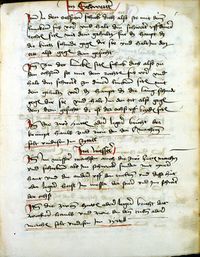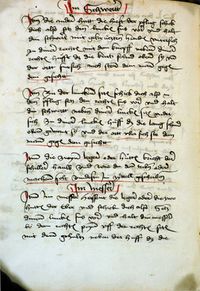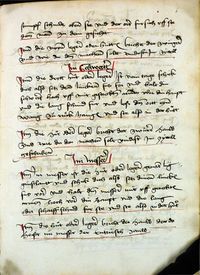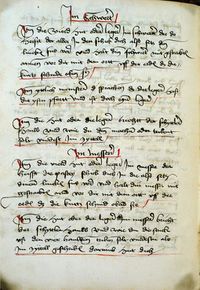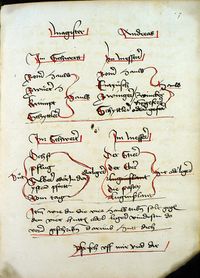|
|
You are not currently logged in. Are you accessing the unsecure (http) portal? Click here to switch to the secure portal. |
Difference between revisions of "Andreas"
| Line 157: | Line 157: | ||
|- | |- | ||
| | | | ||
| − | In the Sword -- In the Messer | + | [21] In the Sword -- In the Messer |
Wrath Strike -- Wrath Strike | Wrath Strike -- Wrath Strike | ||
| Line 170: | Line 170: | ||
|- | |- | ||
| | | | ||
| − | In the Sword -- In the Messer | + | [22] In the Sword -- In the Messer |
Ox Guard or Stance -- The Steer guard or stance | Ox Guard or Stance -- The Steer guard or stance | ||
| Line 182: | Line 182: | ||
|- | |- | ||
| − | | <p>[ | + | | <p>[23]</p> |
| {{section|page:MS M.I.29 007r.jpg|4|lbl=-}} | | {{section|page:MS M.I.29 007r.jpg|4|lbl=-}} | ||
|- | |- | ||
| − | | <p>[ | + | | <p>[24]</p> |
| {{section|page:MS M.I.29 007r.jpg|5|lbl=-}} | | {{section|page:MS M.I.29 007r.jpg|5|lbl=-}} | ||
Revision as of 18:44, 8 June 2015
| Andreas | |
|---|---|
| Born | 15th century |
| Influences | |
| Genres | Fencing manual |
| Language | Early New High German |
| Manuscript(s) | MS M.I.29 (1491) |
Andreas was probably a 15th century German fencing master. He is credited with writing a brief comparison between the long sword teachings of Johannes Liechtenauer and the Messer teachings of Johannes Lecküchner, included in a 1491 manuscript compiled by Hans von Speyer (MS M.I.29). Nothing else is currently known about this fencing master, and he could even conceivably be Andres Juden or Andre Liegniczer, both of whom were apparently German fencing masters and were active before Hans von Speyer's time (Andre Paurñfeyndt is another candidate, though his known fencing treatise wouldn't be published for another 25 years).
Contents
Treatise
Images |
Transcription | ||||||||||
|---|---|---|---|---|---|---|---|---|---|---|---|
[1] In the Sword Item. Put yourself into to Ox thus, stand with the left foot forward and hold your sword on your right side with the hilt before your head so that the short edge stands toward you and hold the point thus toward his face. |
[5r] Im Schwertt / Itm~ In den ochßen schick dich also ste mit dem lincken fus vor vnd halt din schwert vff diner rechte~ site~ mit dem gehultz fur dz haupt dz die kurtz schnide gege~ dir ste vnd halt Im den ortt also gege~ dem gesicht / | ||||||||||
[2] Item. To the left side put yourself in the Ox thus, stand with the right foot forward and hold your sword to your left side with the hilt before your head so that the long edge stands toward you and hold the point thus toward his face. This is the Ox on both sides. |
Itm~ zu der lincke~ site~ schick dich also in den ochsen ste mit dem rechte~ fus vor vnd halt din schwert zu diner lincken site~ mit dem gehultz vor dz haupt dz die lang schnid gege~ dir ste vnd halt Im den ort also gege~ dem dem gesichtt dz ist der ochß vff beÿden site~ | ||||||||||
[3] Item. The two guards or stances break the arc strike and you shall find how to do so in the recital. |
Itm~ die zwo hutte~ oder leger bricht der krümpt haulb vnd wie du den Machem solt vindestu Im zÿttell | ||||||||||
[4] In the Messer Item. You make the two guards also in the messer and place them as with the sword, only with one hand and the other around back, and this guard or stance is named the Steer in the messer and the Ox in the sword. |
Im Messer / Itm~ Im messer machstu auch die zwo hutte~ machn vnd schicken als Im schwertt sünder mit eyner hant vnd die ander vff den rucken vnd disse hu°t oder leger heist Im messer der stier vnd Im schwert der ochß | ||||||||||
[5] Item. The two guards or stances break the rouser strike and you shall find how to drive them in the recital. |
Itm~ die zwen hutte~ oder leger bricht der wecker haulb vnd wie du den tribñ oder mache~ solt vindestu Im zÿttell | ||||||||||
[6] In the Sword Item. The second guard is named the plough, place yourself thus, set your left foot forward and hold your sword with crossed hands downward to your right with the pommel near your right hip, so that the short edge is above and the point is forward and standing toward your counterpart's face. |
[5v] \ Im Schwertt / Itm~ die ander hütt die hiest der pflug schick dich also setz den lincke~ fus vor vnd halt din schwert mit gekrueczteñ hende~ vntersich zu diner rechte~ mit dem knopff neben diner rechte~ huefft dz die kurtz schnid oben sy vñ der ortt fursich auch steñ dem mañ gegen dem gesichtt | ||||||||||
[7] Item. On the left side place yourself into the plough thus, set your right foot forward and hold your sword near your left side downward near your left hip so that the long edge is wended above and the point stands upward toward the counterpart's face. |
Itm~ zu der lincken site~ schick dich also in den pflug setz den rechte~ fus vor vnd halt din schwertt neben diner lincke~ site~ vnder sich zu diner lincke~ hueff dz die lang schnid oben gewant sÿ vnd der ortt vber sich ste dem man gege~ dem gesichtt | ||||||||||
[8] Item. The two stances or guards break the glancer strike and you shall find how to drive or make them described in the recital. |
Itm~ die zwÿn leger oder hu°tte~ bricht der schiller haulb vnd wie du den tribñ oder machen solt vindestu Im zyettell geschriben | ||||||||||
[9] In the Messer Item. In the messer the stances or the two guards are named the boar and place yourself thus: Set your left foot forward and hold your messer near your right leg on the right side with the hilt near your hip so that the blunt side stands above and the point stands out before you into the counterpart's face. |
\ Im Messer / Itm~ Im messer heissent die leger oder die zwo hutte~ der Eber vnd schick dich also Setz dinen lincke~ fus vor vnd halt din messer by dem rechte~ peyn vff der rechte~ site~ mit dem gehultz neben der huff dz die [6r] stumpf schnide oben ste vnd der ortt fur sich vff ste dem man zu dem gesichtt | ||||||||||
[10] Item. The two stances or guards break the restrainer and you shall find how afterward in the recital. |
Itm~ die zwÿn leger oder hutte~ brichtt der zwinger vnd wie du den machen soltt vindestu In zÿttell | ||||||||||
[11] In the Sword Item. The third guard or stance is from the roof, place yourself thus, set your left foot forward and hold your sword up high with arms stretched above your head and the long edge forward and let the point hang a little back and stand thus in guard. |
Im Schwertt / Itm~ die drytt hu°t oder leger Ist vom tage schick dich also setz den lincken fus for vnd halt din schwert hoch vff mit gestreckten armen vber din haupt vnd die lang schnid fur vnd laß den ortt eyn wenig zu° rueck hange~ vnd ste also in der hu°tt | ||||||||||
[12] Item. The guard or stance breaks the thwart strike and you shall find how to do so described in the recital. |
Itm~ die Hu°t oder leger bricht der zwu°re haulb vnd wie du den machen solt vindest Im zÿttell geschriben | ||||||||||
[13] In the Messer Item. In the messer this guard or stance is named Look into Land and place yourself thus, set your left foot forward and hold your messer up with straight arm high before your head and the long or sharp edge standing forward and stand thus in guard. |
Im Messer / Itm~ Im messer ist die Hu°t oder leger genãt lügginßlantt vnd schick dich also setz dinen lincke~ fus vor vnd halt din messer mit vff gereckte~ armen hoch vor din haupt vnd die lang oder scharff schnid fur ste vnd ste also in der hu°t | ||||||||||
[14] Item. This guard or stance breaks the strike named the shock strike in the messer. |
Itm~ die hu°t oder leger bricht der haulb der do heißt im messer der Entriesch haulb | ||||||||||
[15] In the Sword Item. The fourth guard or stance in the sword is named the fool, place yourself in it thus, set your left foot forward and hold your sword before you with straight arms and the point toward the ground so that the short edge is above. |
[6v] Im Schwertt / Item die vierd hut oder leger Im schwertt der do heißt der alber In den schick dich also setz den lincke~ fus vor vnd halt diñ schwert mit gestrackte~ armeñ vor dir mit dem ortt vff der erde~ dz die kurtz schnide oben sy / | ||||||||||
[16] Item. Many masters say that this guard is named the iron door and indeed it is one guard. |
Itm~ yttlich meinster sprachen dz der leger heiß die ysen pfortt vnd ist doch eyn leger / | ||||||||||
[17] Item. The guard or stance breaks the vertex strike and you shall find how to do or drive it in the recital. |
Itm~ die hut oder die leger brichtt der schÿttler haulb vnd wie du den machñ oder tribent solt vindest Im zyttell / | ||||||||||
[18] In the Messer Item. The fourth guard or stance in the messer is named the bastion, place yourself in it thus, set your left foot forward and hold your messer before you with outstretched arm with the point toward the ground so that the short edge stands above. |
Im Messer / Itm~ die vierd hut oder leger Im messer der heisßt die pasteÿ schick dich In die also setz dine~ lincke~ fus vor vnd halt din messer mit gestrackte~ arm vor dir mit dem ortt vff der erde~ dz die kurtz schnid oben ste / | ||||||||||
[19] Item. This guard or stance breaks the strike called the vertex strike and how to drive the elements from the four strikes you will find described in the recital. Guard yourself around them. |
Itm~ die hut oder der leger Im messer bricht der schyttler haulb vnd wie du die stuck vß den vier haulben triben solt vindestu als Im zÿttell geschribe~ darümb hut dich | ||||||||||
[20] Magister Andreas |
[7r] \ Magister / \ Andreas / | ||||||||||
|
[21] In the Sword -- In the Messer Wrath Strike -- Wrath Strike Thwart Strike -- Shock Strike Arc Strike -- Restrainer / waver strike Vertex Strike -- Vertex or threat strike |
| ||||||||||
|
[22] In the Sword -- In the Messer Ox Guard or Stance -- The Steer guard or stance Plough guard or stance -- The Boar guard or stance Fool or the Iron Door Guard or Stance -- The Bastion guard or stance From the roof guard or stance -- Look into Land guard or stance |
| ||||||||||
[23] |
Itm~ wie du die vier haulb tribñ solt gege~ den vier hutte~ oder leger vindestu do vorn geschribñ darünb Hutt dich | ||||||||||
[24] |
/Frisch vff mir vnd dir / | ||||||||||
For further information, including transcription and translation notes, see the discussion page.
| Work | Author(s) | Source | License |
|---|---|---|---|
| Images | Universitätsbibliothek Salzburg | ||
| Translation | Beatrix Koll | ||
| Transcription | Dierk Hagedorn | Index:Codex Speyer (MS M.I.29) |

